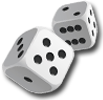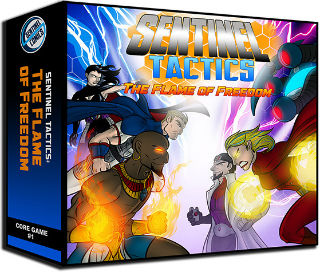



play board games
Board game reviews, strategy tips & session reports
Sentinel Tactics Review
 Stats:
Stats:
No. of players: 2-8
Amount of time to play: 45-90 min
Age requirements: 13+
Set-up time: 5-10 min
Sentinel Tactics is a super-hero themed, skirmish game set in the Sentinels of the Multiverse world. One player is the villain and the other players are the heroes that must stop them.
Sentinel Tactics Rules Description:
Sentinel Tactics lets you take on the role of super heroes (or the villain) and play through scenarios that change based on the previous session’s winner. You can also just play the skirmish mode.
The scenario book gives you the details for the board layout, number of heroes and the villain they are fighting. Some scenarios give some characters scenario specific powers.
Each hero has a character card and a deck of power cards. The character card has tells you the number of actions that character may take per turn, their defense, health and movement plus any powers they always have in play. The power cards tell you what powers they may have and if they require an action or are always active. You start with two powers in play.
Rolling the number of dice shown and taking the die that correlates with the arrow on your character card determines your movement for the turn. So if the arrow points up you take the highest die, to the side you take the middle value or down and you take the lowest value.
Your turn consists of the following phases, Power Up, Surge, Go Time! and To Be Continued. During the Power Up you may switch out one of your in-play powers for one from your deck. Some powers have surge abilities. You trigger these abilities in the Surge phase.
Go Time! is the heart of the action. In this phase you the number of actions noted on your character card. Powers might use actions and you may also move, sprint, aim or dodge. Moving lets you move the value of the die you rolled for your movement value. Sprint lets you move two hexes ignoring elevation. And aim or dodge get you the associated tokens, which I’ll explain during combat. Just be aware aim and dodge tokens you don’t use go away at the start of your next turn. Also you may not use the same action or power more than once per turn unless it is unlimited.
Combat is resolved by rolling dice. Each attack tells you the number of dice you roll when you use it. And which die results automatically miss. Then the defender rolls dice equal to their defense value. The defender may assign any defending doe to any attacking die and if it is equal to or greater than the attacking die’s value the attack is blocked. You may add attack and defense +1 tokens after you roll to get another die to roll. You must use aim or dodge tokens before you roll. They change the values of all the dice to the highest value rolled. For aim tokens this happens after auto-misses are removed from the pool.
For ranged attacks you need line of sight. If you can draw an unblocked line from any point in your hex to your target’s hex, you have line of sight. The number of dots on a hex is its elevation. The more dots the higher that hex. Higher hexes may block line of sight. Counting the number of hexes to reach your target’s hex and then adding the difference in your elevation gets your current range. Ranged attacks miss if your attack roll is less then your current range.
In the To Be Continued phase, you roll your movement for the next turn and trigger any hazard spaces you are on. Hazard spaces may attack you or give you attack and defense -1 tokens. Hazard spaces are put in play by characters’ powers or devices.
Play goes on until the scenario ending is met. Then the winner is determined. The next scenario you play in the same book gives the winning team bonuses.
Quick Review of Sentinel Tactics:
Sentinel Tactics is a one-vs-all game that plays pretty quick. For a skirmish game this one is pretty straightforward and really has a lot of theme. It is great for kids and families too.
The components are excellent and seem really durable. The art is really nice and the scenario books are presented as comic books, which is really cool. The rules are pretty good but vague in some areas. Some quick descriptions seem too easy and they are not organized optimally. Some rules are mentioned for royal rumbles, but maps are not included. These would have been nice to have. There is a glossary, which helps a lot, and this faq should help clear up most questions. The insert is decent but I wish they showed me how to organize everything.
I really like how the scenarios build off each other. I even wish they were more than three scenarios in a story arc. But I enjoy how who wins a scenario affects next one.
The theme in this game is great. It is fun, fast and heroic. The power cards really customize and personalize the characters and add to the theme. Choosing which powers to use in a given situation is pretty straightforward, but sometimes you’ll have a tough decision between a few really great options.
Keep in mind this is a fairly light skirmish game and the dice can sometimes rule the day. This game is great for newcomers to skirmish games. Figuring out line of sight and range is pretty easy. Working out Hazard spaces and their triggering takes a bit longer but after a few games the mechanics should be fairly intuitive. Another thing to be aware of is downtime. This is not too bad with smaller groups but with more than five you could have players impatiently waiting for their turn.
Sentinel Tactics is a light, simple straightforward game that is great for kids, families and players new to skirmish games. The scenarios build off each other, which is cool and you can even make up your own. If this sounds like a game you’d enjoy pick it up. And if given the chance definitely give it a try.
Score and synopsis: (Click here for an explanation of these review categories.)
Strategy 3 out of 6
Luck 5 out of 6
Player Interaction 5 out of 6
Replay Value 5 out of 6
Complexity 4 out of 6
Fun 5 out of 6
Overall 5 out of 6

Leave a Reply